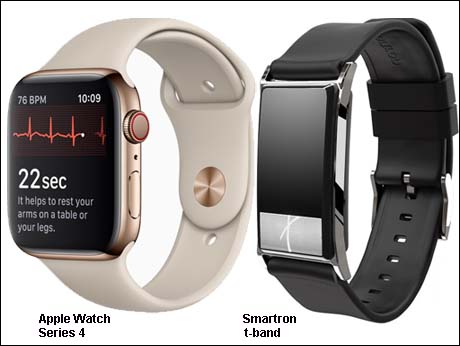
The new Apple Watch has made a subtle shift from health tracker to medical device. But the trend is already here-- thanks to Indian innovation.
September 17 2018: At the Apple launch last week, the jumbo sized iPhone XS Max, overshadowed the 4th generation AppleWatch -- almost. The watch attracted attention, because, in a first for Apple, a health tracking wearable had morphed into a medical device. It did this by adding the functionality of an electro cardio graph or ECG machine, albeit a single lead device, rather an 12 lead -system that hospitals use. Apple uses the ECG sensor to judge if the wearer's heart was beating normally. It sends a notification, if an irregular heart rhythm is detected.
More usefully, the watch knows if the wearer has fallen down. It sends the user an alert which can be dismissed or used to initiate a call to emergency services. If Apple Watch senses immobility for 60 seconds , it will automatically call emergency services. Typical of Apple to tweak an existing function to make it vastly more user friendly!
To loud applause at the launch event, Apple COO Jeff Williams said: "This is the first ECG product offered over the counter, directly to consumers." Not true. Thanks to Indian innovation, we know of at least 2 products where anyone can take an ECG, of acceptable quality without the intervention of a trained medical person.
In June we had reviewed the t-band from the Hyderabad-based Smartron, a Rs 4999 the first smart watch in India, which measured heart rate, blood pressure and captured an ECG trace.
Elsewhere on this site we describe a handy home ECG device that comes from a reputed Indian medical products company.
But a larger question remains: Are ECG traces meaningful in the hands of a patient? Doctors use ECG to measure the electrical activity of the heartbeat to find out if the heart is overworked or enlarged. The hospital ECG machines uses 12 leads to send a tiny electrical signal through the heart to detect any problems. Interpretation is an expert's job -- but the thinking today, is that if a cardiac episode is captured as it occurs, it is more valuable than one obtained some hours later -- the time it takes to reach a clinic. When I whatsapped the trace captured by the t-band to my doctor, he said it was good enough to judge if I had suffered a heart attack or not.
Today's wearables can measure, pulse rate, blood pressure and increasingly, record an ECG. Lay users may not be able to make much of this. But thanks to technology and zippy communications, we can reach it to a doctor and gain that crucial gift of time, they call the Golden Hour.